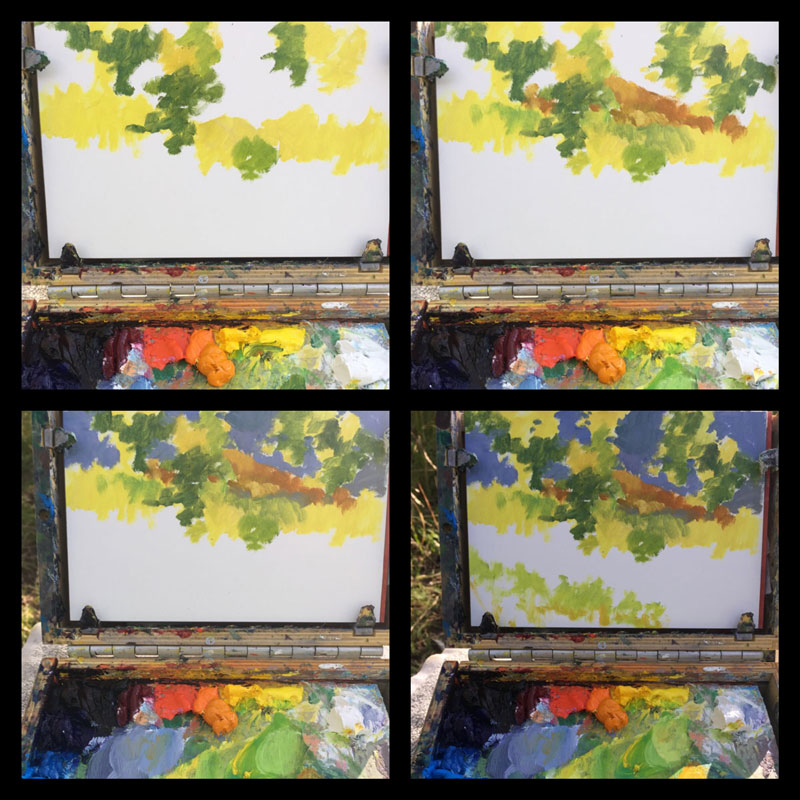 Yesterday a friend shared with me that she’s recently taken up painting, and that she’s “learning and loving it.” (how cool is THAT?!) She further revealed that she’d really like to shadow me at my easel — and that reminded me that over the past few months I’ve taken “process” pics of paintings I’m working on, but I’ve yet to share them.
Yesterday a friend shared with me that she’s recently taken up painting, and that she’s “learning and loving it.” (how cool is THAT?!) She further revealed that she’d really like to shadow me at my easel — and that reminded me that over the past few months I’ve taken “process” pics of paintings I’m working on, but I’ve yet to share them.
So I thought I’d do that now, and since I’ve been a bit infatuated by aspen trees (obvious to anyone who has been following my Dawn Chandler Fine Art FaceBook page lately) I’ll start with a little painting called The Aspen Pillars of My Cathedral, the finished painting featured in my most recent edition of my Inside the Studio newsletter** .
Here we go!
This cluster of photos below — all taken during the course of my painting session — gives you a sense of the challenge I faced when I sat down in the aspen forest early that September morning. Although none of these is precisely the view I painted, they give a sense of the constantly shifting light, color, and endlessly repeated shapes of the aspen forest. ‘Pretty easy for a painter to be intimidated and overwhelmed!
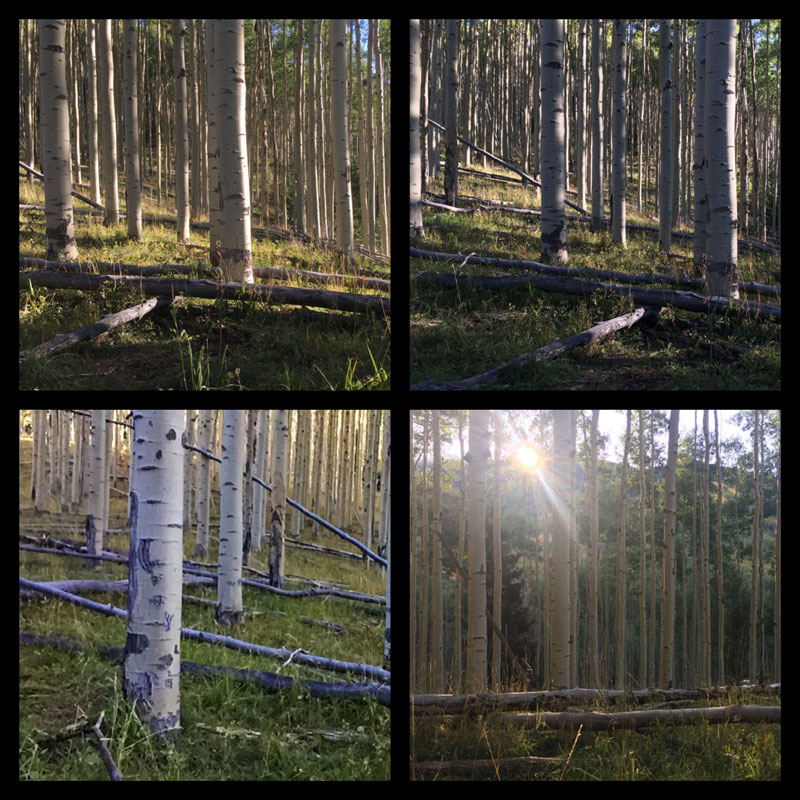
The key then is to simplify: Find something to focus on, and ignore ‘most everything else.
Now, on to painting! Note that I’m using a pure white panel, which is unusual for me. Normally I like to stain my panels (as I explain here). But when I gathered up my paints in the wee predawn hours of the morning, I had no stained panels, no time to stain new ones, and so decided “screw it — I’ll use a white one.” Usually I avoid using a pure white panel or canvas, just because it’s so blindingly and intimidatingly pristine.
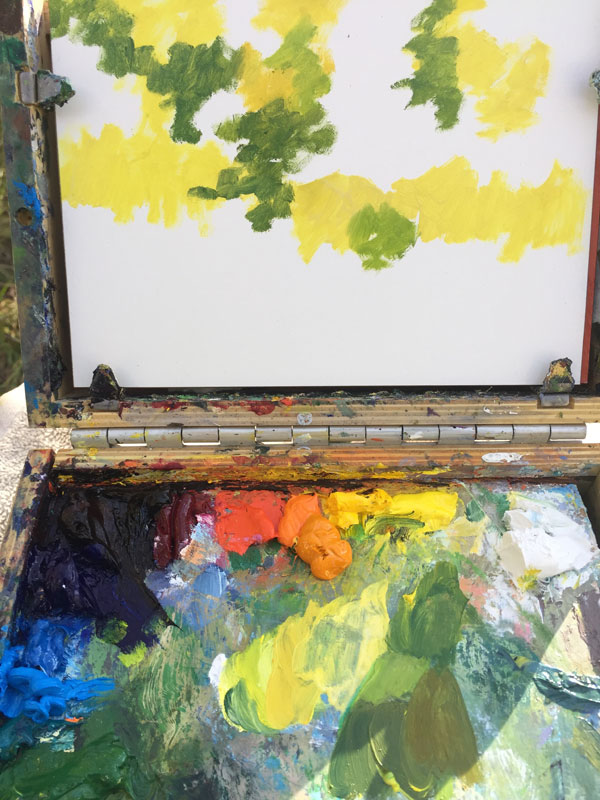
I started by putting in most of the lightest colors first — which is also against my usual tendency to “block in the darkest darks” first. But this scene is so much about the light through the leaves, that I wanted their bright color to radiate and not get mucked up with darks.
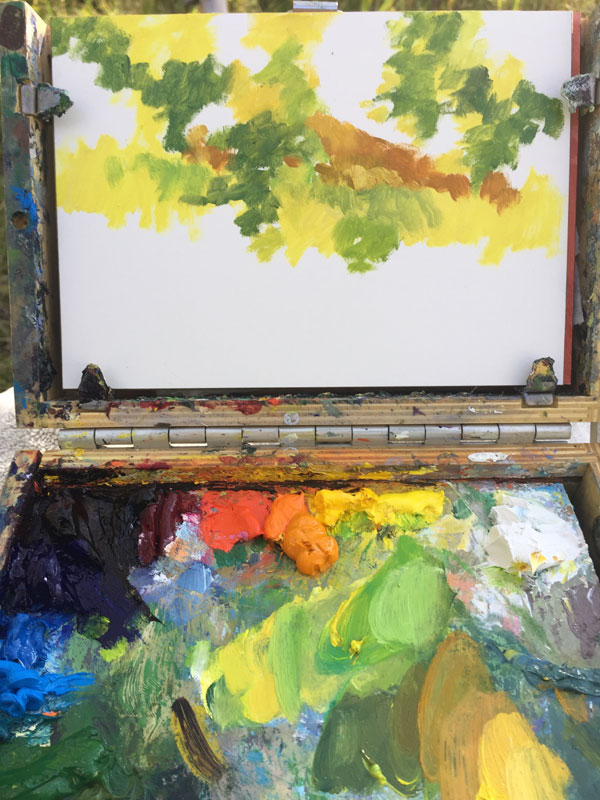
Then I focused on the cool bluey-purple-grey backdrop of the distant mountains peeking through the trees…

Then, the foreground lights….
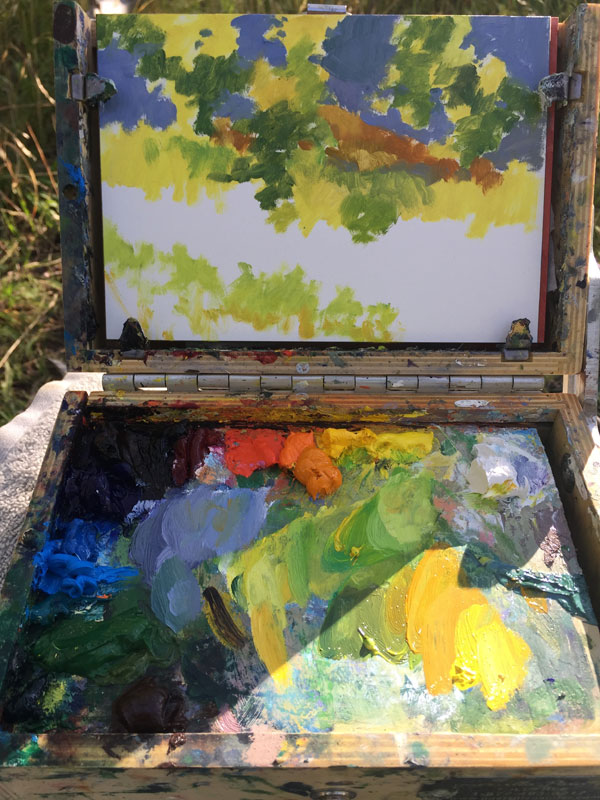
…and mid-ground shadows, noting that while they were a similar bluey-purple-grey of the distant mountains, they were a darker shade.
Note, too, that the contrast of light vs shadow here is also a contrast of colors: Yellow & purple are opposites on the color wheel, and therefore compliments. Mother Nature knows what she’s doing when it comes to dazzling color by pairing these together.
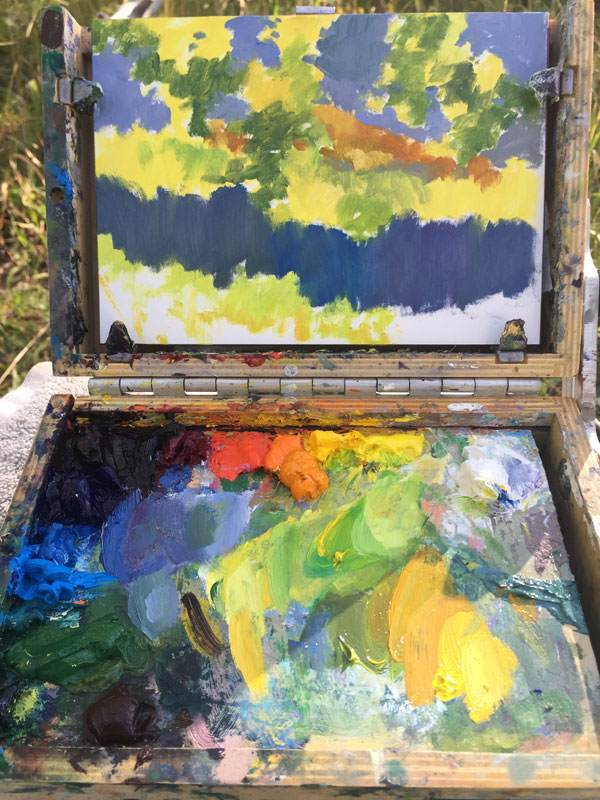
Now to break up that big band of mid-ground shadow with a suggestion of the many aspen trunks and bits of light peeking through. I definitely didn’t want to paint every single aspen tree — that would be distracting and make the painting much too cluttered and busy. Rather, by painting just a few, I suggested many.
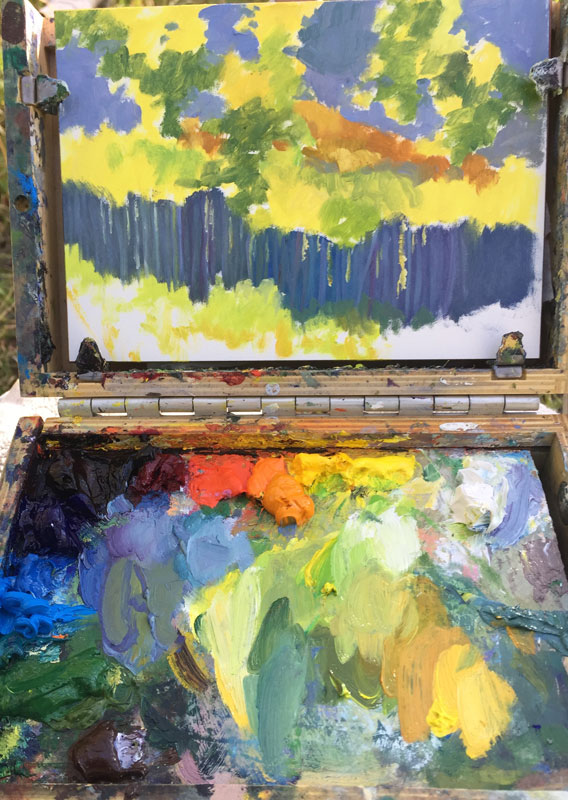
NOW things started to get interesting. For the focus of this painting was to be the aspens in the foreground — which at this point I hadn’t even added to the composition yet!
Normally right from the beginning I would have sketched in at least the shapes of their trunks and worked around them. But that just seemed kind of tedious. So I tried something a bit daring, and with a brush wet with solvent (Gamsol), I simply washed out the paint where I wanted to place the foreground aspens. I did this initially by dipping a clean brush in Gamsol, getting it good and wet with the solvent, and then wiping away/removing the paint from where I wanted to place the larger foreground aspen trunks.
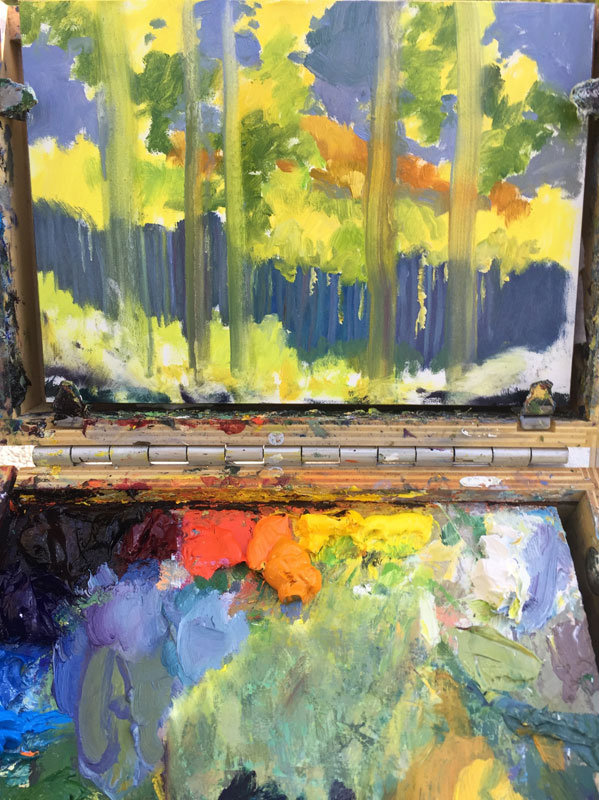
After brushing the trunk areas with solvent I went in with paper towel and wiped the trunk areas, removing even more paint.
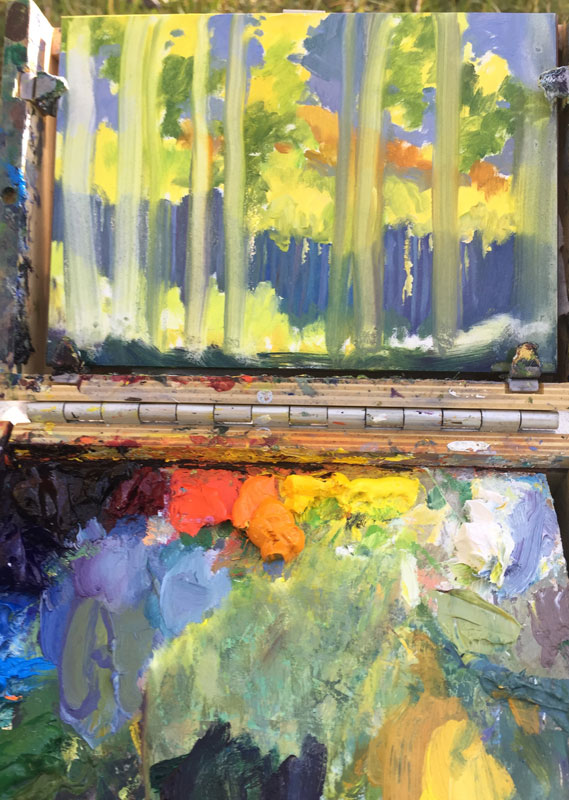
Once I wiped out the underlying paint, I went in with fresh paint to build up the foreground aspen trunks, all of which by this time of day were mainly in shadow.
The perpetual challenge when painting aspens, of course, is trying to ascertain what color the trunks are — especially when they are in shadow. Although we think of aspen tree trunks as pure white, in reality they rarely are. Indeed, since the trunks photosynthesize, often they are tan or muted green. All of them though, because they are light-colored — especially the “white” ones — reflect all of the colors of the forest around them, making them in reality a myriad of colors.
(With a shadow cast across my painting, it appears below much darker than it really is — yet another challenge of plein air painting!)
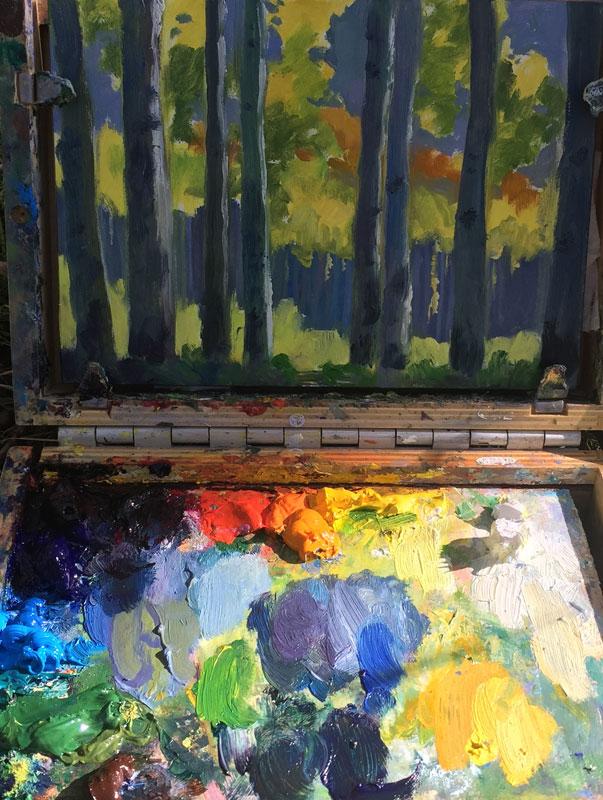
At this point the painting was really coming together, and I got so absorbed with painting that I forgot to keep taking photos of the changes!
(Have you been paying attention to what’s happening on my palette? For I delight in the transformation of the colors on my palette as much as the transformation of the painting!)
I decided I needed to push the background further back, so I lightened the distant purples a bit more, as well as muddled the distant and mid-range foliage a bit, once again thinking about giving the suggestion of forms and space rather than getting caught up in details.
Occasional details though — added at the very end — really help make a painting sing. So a few distinct leaves and bright highlights on the tree trunks go a long way in adding to the sense of light — as well as visual interest.
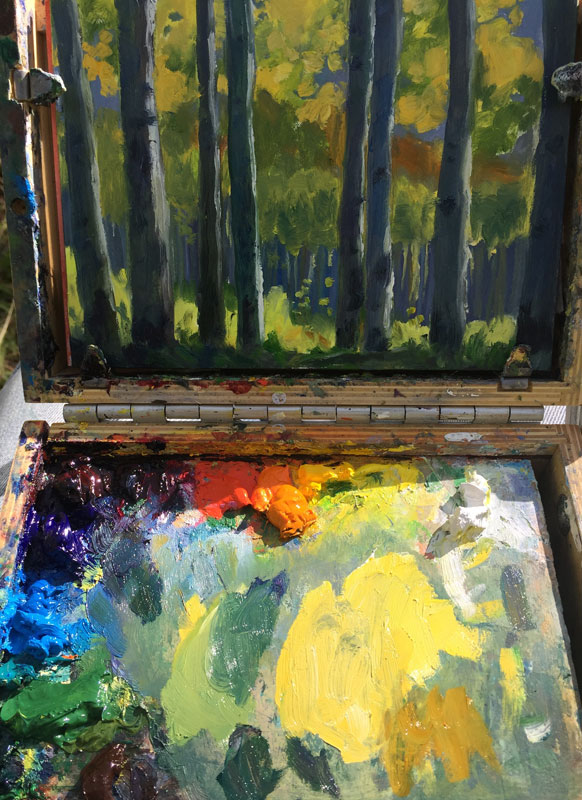
Et voila! The final result! You can see that the painting really isn’t dark at all like it appears in the last couple photos above. Although I kind of like the drama of the painting in the photos above, in reality the painting radiates much more light than those would suggest. Turns out the white of the panel adds a lovely underlying glow to the painting.

The Aspen Pillars of My Cathedral ~ by Dawn Chandler
oil on panel ~ en plein air ~ 5″ x 7″
This painting is available here.
** Gratitude to all you Inside the Studio subscribers out there!
Thanks so much for reading my blog. If you enjoy my musings here, please feel free to share this post!
Also, I invite you to discover more of my stories, insights and art on Instagram, Facebook and via my Inside the Studio Notes — and of course here on my website, www.taosdawn.com
Warmly ~
Dawn Chandler